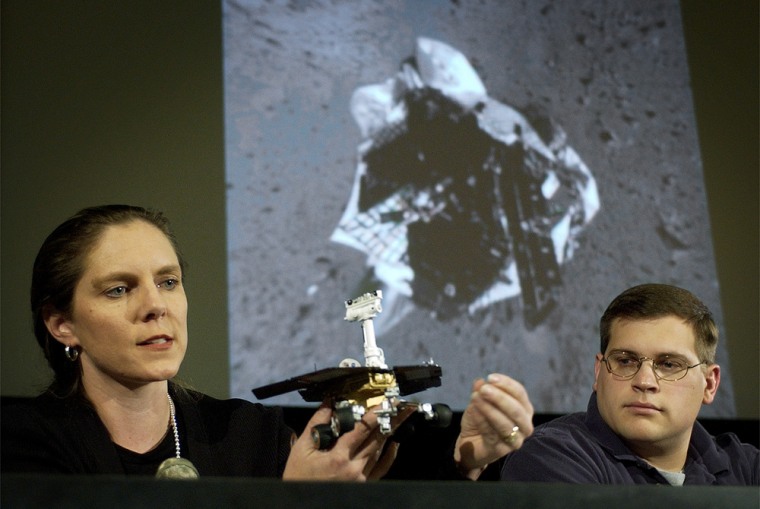NASA’s Spirit rover has unfolded itself and stretched up to its full 4-foot, 9-inch height, making it ready to drive off the lander that delivered it to Mars, the space agency said Saturday.
The rover could reach the Martian surface as early as Wednesday morning.
“It now stands at full height and all six wheels are in their final position,” mission manager Jennifer Trosper said during a news conference at NASA’s Jet Propulsion Laboratory.
The unfolding was one of the most complex deployments ever performed by a robotic spacecraft, mechanical systems engineer Chris Voorhees said. NASA had to fold up the rover to make it fit inside the lander, which opened up like a four-petal flower.
A different route
When Spirit does leave the lander, it will take a different route than scientists had hoped. Airbags used to cushion the rover’s landing are now blocking the ramp NASA had planned to use. Instead, Spirit will turn 120 degrees to its right and take a second, more risky ramp to the ground, mission manager Matt Wallace said.
Even though it remains on its lander, 16 inches (40 centimeters) above the Martian surface, Spirit already has found traces of minerals that could have formed in what might have been an ancient lake at the landing site.
That geologic observation could support theories that liquid water persisted on the surface of the planet during Mars’ ancient past and provided an environment conducive to life.
However, scientists stressed that finding the minerals, called carbonates, does not immediately prove the lake theory. The carbonate dust also could have formed by reactions with the tiny amounts of water vapor found in the Martian atmosphere.
“We’ve got a bunch of ideas and we don’t know which one is right yet,” said Steven Squyres of Cornell University, the mission’s main scientist. A previous NASA spacecraft detected carbonates from orbit.
Taking Mars' temperature
Spirit also was measuring the temperature and makeup of the rocks and soil around it with its thermal emission spectrometer.
The instrument sees infrared radiation — heat — emitted by objects, including rocks and soil. Variations in the radiation indicate differences in mineralogical composition. That’s crucial information for scientists eager to learn what sort of rocks lie strewn around Spirit and which of them are most worth analyzing.
Photographs taken by Spirit of its surroundings have also been trickling in, deputy project scientist Albert Haldemann said.
The $820 million Mars Exploration Rover project includes a second, identical rover, named Opportunity, which is scheduled to land on Jan. 24.
NASA sent the two robotic geologists to prospect for evidence that Mars may once have been a wet world conducive to life.
Mars rover stands up, ready to roll
The Spirit rover has unfolded itself and stretched up to its full height, making it ready to drive off the lander that delivered it to Mars, NASA said Saturday.

/ Source: The Associated Press